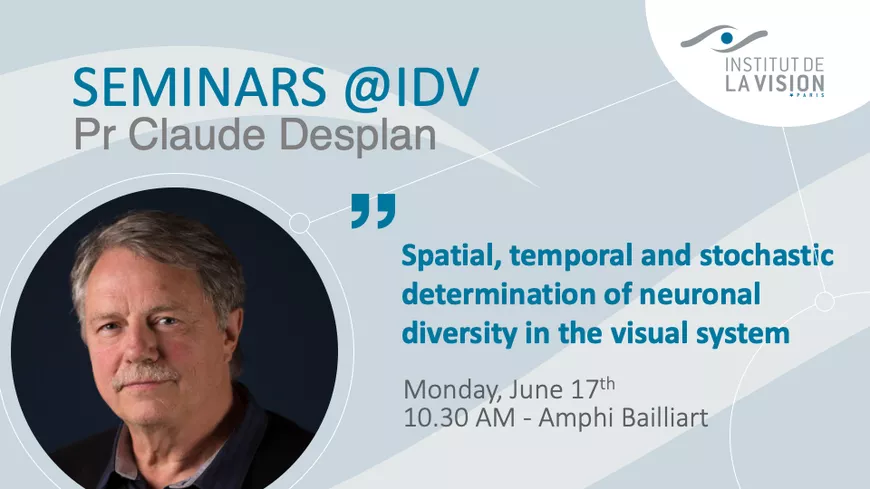Spatial, temporal and stochastic determination of neuronal diversity in the visual system
Invited by Filippo Del Bene and Alain Chédotal, Dr Claude Desplan, (New York University, USA and Affiliate Professor at the CGSB at NYU in Abu Dhabi, United Arab Emirates) will be speaking on Monday June 17th at 10.30 am. RDV in the Amphithéâtre Bailliart, 3rd floor of the Hôpital national des 15-20.

In the Drosophila optic lobes, ~250 neuronal types organized as 800 columns process the inputs from 800 unit-eyes. Neural stem cells in the medulla sequentially express a series of temporal transcription factors (tTFs), producing at each temporal window different neurons that innervate each of the 800 columns. We used single-cell mRNA sequencing to identify the tTFs that specify most medulla neurons. Each tTF regulates the progression of the series by activating the next tTF and repressing the previous one. Furthermore, the neuroepithelium that generates these stem cells is patterned into subdomains by spatial TFs: Although the series of tTFs is the same in stem cells originating from all spatial domains, the neurons they produce differ. Therefore, the integration of temporal and spatial patterning as well as Notch status, are sufficient to explain the generation of the entire neuronal diversity in this brain region.
Finally, we will show how diversity in the brain can evolve to affect specific sensory functions in different species. I will describe the dramatically increased diversity in the mushroom body in ants as compared to flies, as ants rely extensively on pheromones rather than vision for their social life.
About Claude Desplan
Claude Desplan is a Silver Professor of Biology and Neuro-science at NYU and an Affiliate Professor at the CGSB at NYU in Abu Dhabi. Dr. Desplan was born in Algeria and was trained at the Ecole Normale Supérieure in St. Cloud, France. He received his DSc at INSERM in Paris in 1983 working with M.S. Moukhtar and M. Thomasset on calcium regulation. In 1984, he joined Pat O’Farrell at UCSF as a postdoc where he demonstrated that the homeodomain, a conserved signature of many developmental genes, is a DNA binding motif. In 1987, he joined the Faculty of Rockefeller University as an HHMI Assistant/Associate Investigator to pursue structural studies of the homeodomain and the evolution of axis formation.
In 1999, Dr. Desplan joined NYU where he investigates the generation of neural diversity using the Drosophila visual system. His team has described the molecular mechanisms that pattern the eye and showed how stochastic decisions contribute to the diversification of photoreceptors. It also investigates the development and function of the optic lobes where neuronal diversity is generated by spatio-temporal patterning of neuroblasts, a mechanism that also applies to cortical development in mammals. Recently, his lab has also provided a functional understanding of the neuronal and computational mechanisms underlying motion detection.
His laboratory also uses ‘evo-devo’ approaches to understand the mechanisms by which sensory systems adapt to different ecological conditions, from flies to butterflies to ants.
Dr. Desplan serves on multiple scientific advisory boards and committees for funding agencies. He is an elected member of the AAAS, of EMBO, the New York Academy of Sciences as well as the US National Academy of Sciences.
